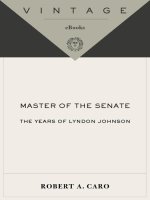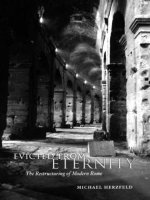Michael herzfeld evicted from eternity the res ome (v5 0)
Bạn đang xem bản rút gọn của tài liệu. Xem và tải ngay bản đầy đủ của tài liệu tại đây (8.25 MB, 369 trang )
EVICTED FROM ETERNITY
EVICTED FROM ETERNITY
The Restructuring of Modern Rome
MICHAEL HERZFELD
FOR STANLEY J. TAMBIAH
who insisted I did this first, with gratitude and affection
CONTENTS
Preface and Acknowledgments xi
Overture: Encountering the Eternal City I
i . Sin and the City 7
Genealogies of Imperfection 8
Monti: Paradoxes of Poverty 9
Sociable Spaces 14
Meeting the People 15
The Village in the City 17
Agonies and Agonistics 22
The Cadences of a Cultural Preserve 27
2. Popolo and Population 39
The Artisans 39
The Shopkeepers 47
Intellectuals and Politicians 49
3. The Wages of Original Sin 53
Accountability and Accommodation: The Pragmatics of Original Sin 53
Original Sinners or Elder Brothers? 57
The Dialectics of Casuistry and Tolerance 61
A Passion for the Past 67
4. Refractions of Social Life 75
Segmentation and Subsidiarity 76
The Civic and the Civil 79
Association Life 85
The Premises of Conflict 89
Theaters of Piety and Peculation 101
A Clergy Scorned 110
S. Life and Law in a Flawed State 115
Laws and Regulations 115
The Limits of Law 118
The (Disreputable) Origins of Legal Loopholes 122
Indulgent Complicities 128
Forgiveness and Calculation 133
Sacred Images and Sinful Spaces 140
6. Scandals of Sociability 143
Friends Who Strangle 143
The Cultivation of Fear 147
Restitution and Redemption 151
Friends Best Avoided 159
A Family Friend? 162
Local Narratives: Swaggering Victims 165
Credit and Default 167
Banking on Fear 172
Tactful Silences 175
7. Extortionate Civilities 181
Accommodations Civil and Civic 182
Discommoding Complicities 183
Uncivil Pleasantries, Unpleasant Civilities 187
Culture and Custom 19o
Peaceful Politics 195
Condominial Civilities 198
Lessons in Civic Civility 212
Spatial and Stylistic Violence 214
8. The Fine Art of Denunciation 219
The Logic of Denunciation 220
Performances of Policing 227
Fractured Authority: The Multiplicity of Policing 234
Extorting Coffee and Campari 238
9. Tearing the Social Fabric 253
Renters and Owners 253
Lawyers and Illegalities 257
Eviction and Evasion: The High Stakes of Time and Place 263
Gentrification and the Last Frontier 266
Endgame 296
Coda: The Future of Eternity 301
Notes 313
References 343
Index 357
PREFACE AND ACKNOWLEDGMENTS
his book is the labor of a love deepened by the realization that Rome, despite its magnificence,
is also splendidly, sometimes tragically, a place steeped in all the weaknesses of the human
condition. My parents first took me there when I was a schoolboy and marked my life with a passion
for this extraordinary place that has only grown with the years. I have tried to convey this powerful
affect, along with the Romans' salty humor and gorgeous architectural frenzies, their harsh social
realities and their warm gregariousness, the appealing fragility of their lives and the towering strength
and self-confidence with which they meet its disappointments as well as its excitements. Monti, the
sector of Rome about which I write in these pages, welcomed me to a world strongly marked by these
human dimensions. No anthropologist, no scholar-indeed, no sentient human being-could ask for more
of any place.
In the work that is laid out here, many people played their parts. Lists are invidious and someone is
sure to be omitted, simply because there were so many who enthusiastically supported my project;
and because so many of the conversations I had with them continue to this day, sometimes briefly
interrupted, but always insistently returning to the themes of a shared passion. A few people
nonetheless made especially sustained efforts, and I want to record my appreciation of their counsel,
insights, and support: Loredana Acca, Paolo Berdini, Carlo Cellamare, Adriana Goni, Luigi
Lombardi Satriani, Berardino Palumbo, Andreina Ricci, Paolo Sciar- roni, Riccardo Troisi, and the
entire Valeri family (Vincenzo, Francesco, Andrea, and Paola). Certain colleagues also offered
helpful advice on specific technical questions; these include the economist Ricardo Hausmann and the
linguist Paolo Di Giovine. Karen Hendrickson-Santospago converted my confusing instructions into a
splendidly legible map. Those generous souls who read the manuscript and offered their extremely
perceptive comments on it-Augusto Ferraiuolo, Cornelia (Nea) Mayer Herzfeld, Douglas Holmes,
Guy Lanoue, Lilith Abdelwahab Mahmud, Maria Minicuci, Borden Painter, Miriam Shakow, and
Claudio Sopranzetti-deserve special gratitude. Carlo Cellamare and Maria Minicuci also arranged
for me to hold visiting appointments in their respective parts of the University of Rome-I ("La
Sapienza") and engaged me in larger and extraordinarily productive discussions throughout these
years of research, while Nea Herzfeld, constant companion in so many places, brought insight and a
generously critical eye to this work as it progressed, besides cementing many of our shared
friendships with the people of Monti and of Rome in general. At the University of Chicago Press, I am
deeply indebted to my old friend T. David Brent, his extraordinarily efficient assistant Laura J. Avey,
and my meticulous, understanding, and stylistically sensitive manuscript editor Mary Gehl. To the
many other friends whose voices are heard with varying degrees of explicitness in these pages, or
who proffered useful advice along the way, my debt is as deeply felt and appreciated as it is wideranging.
While the usual provisos about personal responsibility apply, I do genuinely want to thank the
foundations that helped me bring this work through the main research phase. These are the National
Endowment for the Humanities and the John Simon Guggenheim Memorial Foundation, which
sequentially supported my sabbatical year research in 1999-2000. Harvard University's Weatherhead
Center for International Affairs generously supported a further leave in 2007 and thereby facilitated
much of the writing for this project. My sojourns at the University of Melbourne also provided me
with an invaluable retreat.
All unattributed quotations are my translations of remarks made by informants; I have, except in the
case of unavoidable exceptions (such as public figures or individuals whose role received significant
attention), avoided using their own personal names. Many of them spoke in a mixture of "standard
language" and "dialect," and, while these mixed utterances have sometimes occasioned surprise on
the part of educated local readers, they do represent habits of speech (notably code-switching) that
are themselves useful evidence of subtly but ceaselessly shifting identity politics in social
interactions.
When I began to toy with the idea of doing field research in Thailand, my departmental colleague
Stanley J. Tambiah, a leading light in Thai studies, at first demurred and then showed some apparent
discomfort with the idea-until he was satisfied that I would first pursue my interests in the comparison
of Greek and Italian nationalisms. When I told him that I intended to go to Rome before I attempted
anything substantive in Thailand and asked him for a letter of support for one of my fellowship
applications, he immediately responded with all the extraordinary generosity and care for my
scholarly life that had, it became entirely clear, animated his original concern and hesitation. Tambi,
whose personal modesty and kindness are as legendary as his intellectual inspiration, has, quite
simply, made all the difference. He also shares my enthusiasm for Rome as a city. This book is, in a
very real sense, a response to the combination of intellectual stimulation and radical kindness that he
has brought to all our encounters, and I dedicate it to him with the deepest and most grateful affection.
Cambridge, Mass.
May 2008
OVERTURE
Encountering the Eternal City
he three proud, angry women made their stately way down from the lofty offices of the Rome
municipal administration overlooking a square designed by Michelangelo atop the remnants of the
ancient Capitol. They crossed the triumphal road that Mussolini had cut through the ancient forums
and headed determinedly toward their homes somewhere behind the emperor Trajan's markets-today
upheld by the proponents of a remorseless neoliberalism as a precursor of malls. Their fury at the
failure of local politicians to protect them from eviction from their homes by those same neoliberal
forces seeped into their dignified, measured steps and their fluid gestures of deep affront. The
bureaucrats could play a delaying game, but in the Eternal City the local people still determined the
tempi, the rhythms, of social engagement.) Their deliberate pace, in which a knowledgeable observer
could easily recognize the imperturbable self-assurance of Roman artisans and shopkeepers,
promised long months of caustic confrontation still to come.
I write these lines, conscious of my own anger at the failure of imagination that today makes the
ancient capital of empire and church the scene of a potentially explosive housing crisis-one of the
worst in Italy's history, but a reflection of processes occurring in many parts of the globe today under
the pressures of the new international economy. And I look again at what I have written. Out of
context, it probably makes little sense. My words describe the debris of ruined lives-the tip of a
rubbish heap, like the ancient landfill of broken pots that became the modern working-class quarter of
nearby Testaccio. Fragments of the past are everywhere. An elderly Jewish vendor who survived the
Nazi dragnet declaimed in staccato bursts that he had counted every one of these stones, his upthrust
lower lip and sharp bristly chin pointing to the very heavens in outraged protest. Traces of multiple
pasts are piled up in artful disorder, scattered and shattered among the dying homes. They are a
lunatic archaeology's scrambled detritus, now promiscuously straddling a prose that can only hope to
do justice to the pained beauty of this place through the recitation of its own failures, its own
falterings before the layered magnitude of both disaster and triumph.
We are in the heart of old Rome, in Monti, erprimo rione de Roma-the first district ~rione~ of Rome,
whether historically or in importance is never clear, and is there really a difference? This is the
ancient Subura, red-light district then and now, a marginal place in a capital that for many has itself
been marginal to its encompassing nation, a city of bureaucrats and workers despised by other Italians
for their allegedly uncultured ways. Monti is luscious with the magnificently stained grandeur of
baroque architecture, interspersed with reminders of high antiquity as well as the intrusive,
heavyhanded trumpetings of nineteenth-century and fascist grandiloquence. It offered a sensuously
attractive context in which to conduct fieldwork; but that same beauty had brought the blight of
gentrification. Many residents were welcomingly eager to share their thoughts and knowledge.
Monti, like the whole city, was experiencing a focalization of global connections that would have
seemed familiar to its ancient forebears. A German physics student stood in the quiet street where I
lived recording a solar eclipse; a Peruvian couple living nearby stopped to watch, and they were
joined by two Asian women as well as three local artisans, including a printer and an ironworker
who had set up his own makeshift equipment for the same purpose. Such scenes were not unusual. At
the end of the street, the owners of a Chinese restaurant-well respected and long established in the
neighborhood-exchanged pleasantries with customers in the distinctive cadences of the city. Other
immigrants were less popular, and there were some nasty expressions of racism. But those who had
mastered the local courtesies won more approval than wealthy Italians who had moved in without
showing any interest in their neighbors' lives.
When I first started exploring Monti, a friend who accompanied me on one of my forays, himself a
university professor, courteously greeted a familiar-seeming gentleman who turned out to be a former
leader of the Italian Communist Party. This man, Giorgio Napolitano, had become the president of the
Republic by the time I set to writing this book some years later. Residents would point with pride to
the imposing building where he lived; a butcher, also a Communist, was especially proud of
supplying such distinguished figures with prepared meats. Romano Prodi, then president of the
European Union and twice prime minister of Italy, had lived in temporary quarters in a Residence
almost directly opposite our house. An ironworker had been evicted from his home in the building
where Prodi now resided. Monti, said he, is no longer for the poor! Even those not directly affected
by the arrival of famous neighbors display an ambiguous mixture of pride and exasperation. One
resident lamented that half the district had been taken over by rank outsiders-actors, politicians,
prostitutes! Given Monti's ancient notoriety, his observation perhaps encapsulated a touch of perverse
pride.
The process he described is that of gentrification-the upgrading of a rundown residential district.
Those who have the wealth to purchase elegance pursue the new fashion for old houses, with
disastrous consequences for lower-income inhabitants. Monti, at the core of Rome's historic center, is
one of the last major complexes of centuries-old residential buildings to yield to the heritage industry,
despite the presence of signature monuments of Western civilization-the Colosseum, the imperial
Forums, the churches of San Pietro in Vincoli and Santa Maria Maggiore, and other architectural
gems representing every phase of Roman history from the early Republic to the Fascist era. This
historic center has become a UNESCO world heritage site. Cosmopolitan fashion now invests
owning and inhabiting a piece of an allegedly universal history of civilization with irresistible
appeal; the rhythms of daily sociability surrender to the commercialization of eternity. The
newcomers may not be as uninterested in the district as these poorer residents imagine, and indeed
have constructed their own social lives both within and outside its confines. Deepening class
divisions have nevertheless created an unfortunate collective impression of disengagement and
hauteur.
Those locals whose lives are now being ravaged by an epidemic of evictions are especially aware of
the irony whereby those who displace them can proclaim themselves the guardians of a national
heritage. The key term here is patrimonio-usually translated into English as "heritage" or
"inheritance" and the central theme of official discourse of historic conservation. Like the English
term "heritage," but with an added patrilineal emphasis,' patrimonio evokes notions of a material
inheritance given in trust for future generations. Rome is not only a city rich in historical monuments
belonging to Europe's civilizational past but is also the capital of a nation-state that has yet to
complete the work of consolidating a national identity-a fact that throws into high relief the intense
contrast between those who speak of a national heritage and those who instead emphasize their
birthrights as Romans and indeed as residents of a particular neighborhood.`
Another term, civilty, conveys the lofty evolutionism usually associated with "civilization" in English
and socially realized as urbanity. It is impressively cognate with "civility," which certainly forms an
important component inasmuch as good manners make for easy social relations. But it only represents
the civic virtues insofar as these also contribute to the maintenance of social calm and order. People
sometimes become very uncivil when they think that their civic rights and responsibilities are being
usurped.
C0w
The idea of civilta is, for many Italians, part of their patrimonio as Europeans, as Italians, and as
inhabitants of a particular city. Those who purchase a share in the historic center of a city such as
Rome are claiming possession of a majestic civilizational status, one they contrast with the rough
manners of the Roman working classes. For their part, the artisans, laborers, and small merchants
who constitute the majority of the older population reject that claim to superior status and knowledge.
The conflicts that emerge over eviction are primarily over living spaces and economic rights and
goals. But they are also, and in parallel fashion, about cultural capital. The new residents are not
simply enjoying the benefits of their greater economic power; they are also redefining the significance
of the capital, Italian identity, and the future of a past claimed by many groups of people. The global
implications of gentrification and the class conflicts that they generate, implications that are certainly
replicated in widely differing sites, are filtered through local perceptions and practices in each.4
Rome offers a peculiarly effective magnifying lens for examining these issues, because the global
significance of its history comes perpetually into conflict with the parochial loyalties of its residents,
and because the current process of gentrification has occurred at a time when the city's housing crisis
has become a matter for international concern. Rome was a center of globalization long before the
term was ever coined. It is the administrative and spiritual center of the Catholic Church, which,
having willingly accepted the mantle of the long-defunct secular empire, has perhaps been the
longest-lived and most geographically ramified and then locally refracted global project in human
history' This study can serve as a counterweight to both the generalizations of the globalization
literature and the exclusivist rantings of Fascism disguised as a defense of local cultural rights. I hope
to show that neither stereotype adequately describes or explains the sometimes excruciating
complexities of life in one of the most tragically beautiful products of human artifice anywhere in the
world-a city dubbed "eternal" where not only the buildings but the very people themselves are being
"restructured."
CHAPTER ONE
Sin and the City
othing here is perfect; everything, even failure, is magnificent; and prose must reflect the
gnawing putrescence that strangely enhances the city's aging beauty, veining its robust surfaces with
splinters and fractures that intimate the fragility and contingency of its social life. Rome, after all, is
the capital city of a country that has fought a long and complicated battle with a corruption of which
its citizens are not totally, sometimes not even at all, ashamed. Rome is also the capital of a religion
that allows its devotees to appeal to the imperfection of original sin not only as an explanation of
their venality but also as a pretext for sustaining it-where even popes and cardinals could order
musically gorgeous masses, sung by brilliantly robed choirs, to save their souls from the sordid acts
that scattered their seed among the city's underworld.
An entire government office works tirelessly to recapture a small fraction of unpaid fines for building
violations by offering absolution on a papal model of confession and repentance; perhaps this is why,
as one architect remarked as we scanned the whole city from a high rooftop, in the end most of
Rome's gloriously riotous accumulation consists of violations of legal building codes. There is a
saying in Rome-"What the barbarians did not do, the Barberini did" (Quello the non fecero i barbari
fecero i Barberinfl-that recalls Pope Urban VIII's and his nephews' despoiling of the Colosseum for
the ornamentation of their family palace in 1623 .' A city policeman invoked this historical allusion to
criticize Mayor Francesco Rutelli's expropriation of a public garden and palazzo and his destruction
of hundred-year-old pine trees in order to construct a reinforced concrete jubilee information booth
with money provided by the Volkswagen corporation. Perhaps, too, he intended a sly allusion to the
once strongly anticlerical Rutelli's sudden embrace of the Vatican and his cooperation with the papal
authorities in the construction of huge new works ostensibly meant to facilitate the celebration of the
jubilee of 2000.2 His comment exemplifies the Romans' cynical familiarity with the events and
personalities of the past and their recognition of its echoes in the present.
Genealogies of Imperfection
Sin, no less than virtue, has its genealogy-a genealogy that links ordinary men and women with popes
and politicians, priests and police officers. And it is a genealogy embedded in the torrent of speech
through whose self-consciously working-class, dialect-inflected cadences so many Romans celebrate
their ironic skepticism about everything represented by the nationstate of which their city is the
grudging capital, much as they lampooned the papacy and its temporal powers through the device of
the "talking statue," Pasquino, during those earlier times.' It is certainly relevant to my story that in
recent years Pasquino has again begun making acidulous fun of the municipal and national authorities,
most often in a saucy rendition of Roman dialect that recalls his baroque versifications. And it was
Pasquino who coined the famous phrase about the Barberini that my police acquaintance found so
apposite to current affairs.
Romans must come to terms with a corruption so pervasive that perhaps it could only have emerged
in an ancient seat of religion and power.4 The Spanish libertine pope Alexander VI (1492-1503 even
erected a monument marking the place under its ancient name of Subura; the humorless bureaucrats of
the municipality have carefully juxtaposed a street sign reading Piazza della Suburra to show that
they, at least, can spell their Latin (and thus have it wrong! ~, and do not use dialect (which uses the
same spelling as the Latin! ~-although in another neighborhood some local authority insisted on
dialect signage as well. But what these competing monumentalizations conceal is that Subura was the
red-light district of ancient Rome, and that it still houses a brothel population, formerly the haunt of
military conscripts and even of priests-who, after all, are people of flesh themselves, as one local
indulgently remarked, and are thus as corruptible as any.5
These are resilient realities. In 1948, the state tried to close down the bordellos, but some were
subdivided into tiny units that could be rented to the prostitutes on an individual basis, allowing them
to return to the secretive work and ways of their trade.' When the police recently charged two
madams-one aged 79, the other 83-with sexual exploitation, locals were bemused; these revelations
hardly came as a surprise.7 Today, however, some right-wing localists profess to hate the fact that the
familiar old madams and whores of the "houses of convenience" are increasingly displaced by
women from Eastern Europe. Those women of earlier times were "our stuff," said one.
Even the more permanent, architectural features of the district bear witness to intimate secrets.'
Alexander VI's monumental marker of the Subura connects a tawdry antiquity (Augustus built a huge
wall, still extant, to shield the forum from the district's notorious fires, dirt, and criminals) to more
recent imperfections (echoed yet again in the new spray-paint graffiti over the lower half of this
monument) in the heart of grandeur and faith. Another good example of spray-paint wisdom, this one
in the main square, told the Lazio soccer team to "eat its liver out" with a bitter blend of regret and
jealousy when the Roma team triumphed. Graffiti are indeed everywhere, along with neglected
garbage dumps; and, while this is not unusual throughout Italy, their presence in Rome often asserts
the salty intimacy and lacerating self-criticism associated with the dialect. "Romani monnazzari,"
(Romans [are] garbage-people) declared one spray-painted dialect inscription, perhaps objecting to
the dumping of waste outside the author's house (as a friend of mine speculated), but in a language that
made it clear that this generic complaint was for domestic consumption only-a language too coarse, as
some Romans insist, for more public use. But Monti has also tried to glorify the same language by
linking it to a celebrated folk tradition that is itself a remarkably durable expression of cultural
intimacy; a monument to the writer Ettore Petrolini, author of a comedy about a local tough (Gigi er
Bullo), praises him for reviving the language that "gave Pasquino to the Roman people."
This city of saucy impertinence and robust scandal is a national capital, albeit an eccentric one; a
study of Roman life should have something to say about the nature of the state and the relationship
between the capital and the nation of which it is the symbolic center. Ethnography offers especially
persuasive answers, since it provides grounded access to the lives of the citizenry, including those of
bureaucrats, intellectuals, and politicians. Rome's peculiar marginality to its own nation-state-like
Monti's notoriety within the city-offers a rich opportunity to delve into the dimly illuminated alleys of
cultural debate and to peer behind the public stage of monumentality.
Monti: Paradoxes of Poverty
The tales of madams and prostitutes, of houses built illegally and corruption in high places, and of a
scabrous language considered to be especially fit for comedy and satire illustrate the heart of the
seeming paradox that is Rome: the religion that has made its headquarters in this city defines its flock
as unavoidably mired in sinful weaknesses and, by accommodating to those weaknesses and
organizing various forms of penance through which the penitent can then seek redemption, both
exercises enormous power over the population and provides a model of exploitable compromise that
the various secular authorities have often been eager to follow-not least in their organization of urban
space.9
Monti, in particular, is quite literally a sunken district-its streets lying several feet below the
nineteenth-century thoroughfare of Via Cavour, its houses reproducing-so it is said-the forms of
ancient dwellings or shadowing the final stages of all the roads that have forever led to this city of
Rome.1° Monti is "below the city" (sub urbe), as the name Subura is sometimes taken to implyl I today, physically below the busy arteries attesting to Rome's sudden emergence as a busy capital city
after 1870, in a stark display of physical as well as moral stratigraphy that has struck professional
urbanists and novelists alike. By mid-morning, there is always an air of expectancy in the streets.
Even on busy Via Cavour, the nineteenth-century artery that slices through the old quarter, the tingling
smell of celeryflavored broth being prepared in one of the many restaurants can still overcome the
aggressive fumes emanating from the cars screeching their way down to the Via dei Fori Imperiali.
Everywhere there are deep shadows and steep side streets. The noise of traffic racing down Via
Cavour and the roar of protest songs and slogans from the huge demonstrations that in the afternoons
often snake their way down that broad thoroughfare to the ancient forums and Piazza Venezia seem to
work their way in from a chaotic, burning, upper world, seeping into the secretive quiet of Monti's
domestic spaces and intimate squares. The traffic that tries to force its way down Via del Boschettonamed for a "little forest" long since displaced by the old palazzi that line the cobblestoned roadwayis a brash intrusion. And when the glowing light of the sunset echoes in the ochers and russets of the
facades, their lower reaches are already quite dark, only intermittently illuminated by the gentle light
from the studiedly antiquarian electric streetlamps and, on special occasions, from the cupped
candles of pilgrims visiting the sacred images that punctuate and accentuate the domestic intimacy of
this shy, deep place. Light glows from windows, revealing wooden ceiling beams; briefly glimpsed
through street-level doorways, winding, rickety stairs give access to the upper floors.
The depth is historical. It displays, as in a stratified archaeological site, the wild historical and
aesthetic profligacy with which Rome has been blessed and cursed. The architect Riccardo d'Aquino
invokes a Braudelian sense of the longue duree to suggest that the sense of belonging to a particular
place, to this remarkable city, is a product of indirect emotional attachments generated by a specific
pattern of relationships between elements of the built environment and the local culture.12 There is a
continuous interplay among institutions and individuals, producing continuities as well as ruptures
and especially focusing on the play of eternity and evanescence evoked by the pervasive presence of
ruins-of fragments of a past made present by their constant incorporation into the living city. The
dramatic artificial lighting that is one of the glories of Rome today has precedents in the romantic
prints of Piranesi and others, taking advantage of the way light can reveal unsuspected structural
features exposed in a suspended state of collapse.13 Rome exists in a state of perpetual tension
between monumentality and the sprawling disarray of untended ruins.
That tension reflects the experienced realities of social life as well, the practical challenge of living
an ordinary life in a city that is truly the cynosure of the Western world. Time, the teachings of the
church remind us, is the source of the imperfections in all human existence; that life is necessarily,
and nowhere more than in Rome, a shifting compromise between the lofty ideals enshrined in
monumental architecture and scriptural writ on the one hand and the makeshift adjustments
necessitated by social life on the other. What gets preserved may not always follow the dictates of the
state. Residents of Monti, despite their leftist sympathies, refused to follow the general destruction of
Fascist insignia when their own war memorial was in question, because this would have meant
desecrating their own deadvictims of Fascist geopolitics, to be sure, but above all else kinsmen and
neighbors in a tightly knit community.
A persistently disobedient streak in the self-representation of Romans allows them to experience
continuities in the numerous violations of laws that might otherwise fix the city's architectural fabric
in a temporal vacuum. The political scientist Filippo Sabetti has addressed the question of why Italy,
long the site of apparently dysfunctional administrations at virtually every level, has nevertheless
achieved an enviable reputation in many fields of human endeavor, including the economic.14 He
especially explores a set of laws relating to the planning of Rome, in which, like other scholars, he
identifies a persistent pattern of compromise between theoretical legality and practical necessity,
built, as often as not, into the legal provisions themselves." Rome is the capital of this paradoxical
country; it is also one of those places where the sometimes outrageous deployment of the resulting
ambiguities depends on a remarkable mixture of ironic humor, inventive casuistry, and agile
adaptation.
That cheeky vitality, as much as the solidity of the Colosseum or of St. Peter's, is the substance of
Rome's capacity to remain recognizable through the centuries. It offers an alternative eternity to those
of the grand sweep of ancient history or the eschatology of a power-saturated church-or, rather, it
offers a set of eternities, fragmentary snatches of social experience, of a way of life embedded,
reworked, and recaptured in the interstices of the city's most imposing structures. True, the ruins have
been idealized, by locals as much as by the tourist hordes; but the fast-talking modern centurion
impersonators who demand fees for being photographed at the Colosseum, and the impudent spraypaint graffiti announcing that "Rome is pagan," are no less integral to the invocation of history than the
most solemnly restored and framed of the ancient temples and baroque churches. The continuing battle
against a state whose representatives are themselves implicated in a wide range of scams and
schemes is a far richer source of temporal profundity than are the pronouncements of formal
historiography.
The paradox of a great city glorying in the mire of its corruption-a metonym of that larger paradox of
the perverse Italian nation-state-is etched in brilliant, deep lines filled with the grime of a hard life.
Romans, with a few exceptions (such as the bourgeois residents of Parioli), like to think of
themselves as working-class. Their often deep dislike of the Vatican, intensified rather than muted by
a religiosity and a respect for the sacred that they have made very much their own, springs in part
from a collective social memory of oppression. It permeates the smallest details. Not least among
these is the distinctive Roman diet; a butcher pointed out (and this was a claim I heard several times)
that Roman specialties of offal-the famous pajata (stewed intestines), coda vaccinara (oxtail), trippa
(tripe), and coratella (chopped heart and innards)-reflected the fact that the princes of the church took
all the best pieces for themselves. Little regular meat remained for the masses, and the butcher
claimed that the unusually thin slices that characterize his craft reflect that paucity.
But note how Romans here snatch self-respect from humiliation: the slices are thin, yes-but the
butcher describes them as delicate and fine, reflecting a culture that concedes nothing to deprivation.
A Roman expression decrying stinginess and greed-"We don't eat so that we don't have to shit" Nun
magnamo per nun cagal6 )-also reflects the conviction that the Vatican deprived the people of their
daily bread to build its wealth. I heard this proverb in the context of a complaint that the Vatican
inherits the homes of those heirless but wealthy unfortunates in whom the terror of eternal damnation
can be made to induce paroxysms of piety in anticipation of their departure from this earthly coil.
It is not, after all, as though Romans are indifferent to the quality or quantity of what they eat; they are
not ascetics by cultural choice. To the contrary, food is one of those areas in which Romans revel in
their distinctiveness-a space of cultural dialect, no less the object of derision by outsiders than their
rough speech. A salad of young chicory shoots in an anchovy-flavored vinaigrette (puntarelle~-like
the dishes of offal, a poor people's food-is virtually unknown fifty miles from the capital. And food is
the anchor of memory; a man facing eviction from the house in which he was born recalled, in a
moment of despair, "chicken with peppers and the strange smell of exquisite things"-whereas today,
he said, they simply eat a sandwich, a common, ready-made convenience such as one would find
anywhere.
The local diet is austere in terms of prestige, and reflects a history of poverty, but it also serves as a
proud marker of Roman distinctiveness. Romans insist that its defining richness is not some elaborate
set of sauces but the agile, split-second timing of its production; it is, in other words, a living tribute
to manual dexterity and quick wits rather than to monumental recipes moldering in leather-bound
tomes. It is very much a part of social interaction, which is why festive meals are often recalled; and
the precise tempi of its production insinuate a refined artisanal sensibility that is, again, ingrained in
bodies and memories and reproduced in a delicate appreciation that the more luxurious cuisines of
other regions might drown in rich and creamy sauces.
Many Roman dishes also recall the cultural significance of the Jewish community, itself a monument
to past poverty and deprivation and today credited with having conserved ancient recipes that would
otherwise have been lost centuries ago. Other dishes, in an unholy but tasty alliance with these
culinary emblems of the Ghetto, reflect the products of the pig farmers in the Amatrice hinterland.
Both these genealogies are, let us again recall, genealogies of poverty and deprivation. Both have
proved extraordinarily resilient. Their intermingling represents the habit of accommodation that
Romans stereotypically, and repeatedly, attribute to centuries of evading the cruelties of papal power.
There is still a widespread feeling that the Vatican's presence is oppressive, so that it is necessary to
hold back from criticism or resistance-"because, if you don't, you can't live."
Despite its history of local poverty, Rome is still, whether its citizens like it or not and many do not),
the national capital. What happens in its intimate side streets reflects and refracts decisions made in
its grand administrative palaces and in the halls of international conference centers, not only as part
of the continuing attempt to harmonize local life with national and transnational bureaucratic
institutions, but also because, at the end of the day, many of these influential bureaucrats are either
Roman themselves or have been transplanted to the city and must live with the city's realities.









